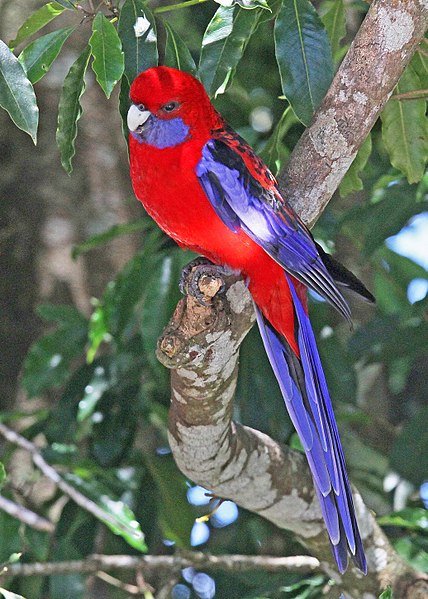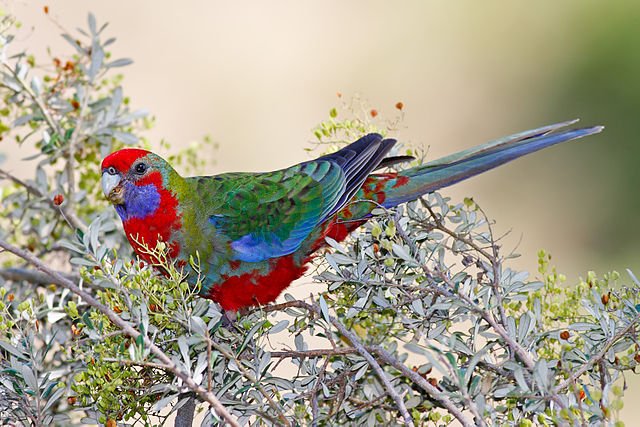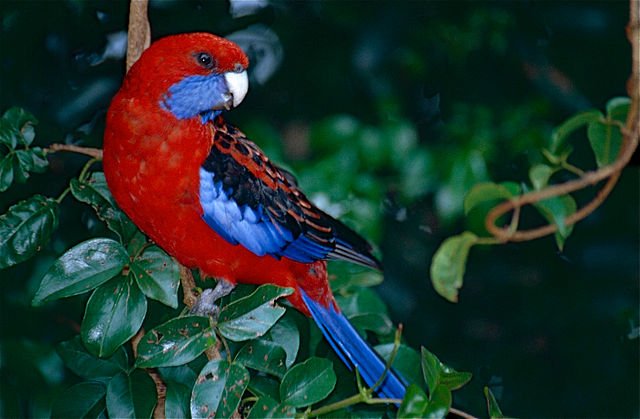The crimson rosella, one of Rosellas, is popular among parrots due to their stunning color combination and enchanting whistle sounds. Not only that, but they also have some other traits that make the crimson rosella different from other species of parrots. So, let’s learn what type of quirks and perks, these feathered companions have compared to other species of parrots.
Crimson Rosella Traits and Features
Generally, parrots vary from a small size of 5 inches (E.g. Lovebirds) to large size of about 40 inches (E.g. Macaws). However, the crimson rosella is a medium-sized parrot with the size varied from 10.4 to 14 inches, whereas their wings are 6.5-7.5 inches long.
Besides having different sizes, parrots also inherit various colors based on their species. While some parrots show vivid multiple colors, such as Lories, some have only two or one colors, like Vasa parrots. In this case, the crimson rosella is a colorful parrot with two or three color combinations. Their plumage is mostly red with violet-blue cheeks.
Crimson rosellas have black nape, back, and secondary parts, like shorter and upper “arm” feathers, with a broad red edging. Also, the inner median wing-coverts are black, whereas the bend of the wing, outer median wing-coverts, and secondary coverts are blue in color. Moreover, secondary flight feathers, outer webs of the base of primaries, and under wing-coverts are blue.
Their upper side of the middle tail feathers are dark blue with a black base, and the outer tail feathers are also dark blue with a lighter edging and pale tips. The tail underside of the crimson rosella is pale bluish. This is how an adult male of the crimson rosella looks like, and adult females and juveniles slightly differ from these colors.
More on Gender differences here: https://parrotquaker.com/crimson-rosella-gender-differences/
In other parrots, sometimes, males and females of some species look totally different and such parrot is Electus. However, when it comes to crimson rosellas, males, females, and juveniles are not completely different, but they are varied with slight changes. The female crimson rosella’s plumage has a greenish tinge to the upper side of the middle tail-feathers, while the juveniles have olive-green plumage instead of the red plumage in adults.
Rosella Native Region or Natural Habitat
Most parrots live in tropical or subtropical areas in South America, Central America, Africa, and Australia, however, their natural regions and habitats vary based on their species. Generally, parrots come from America are sometimes called the New World, whereas those come from Africa and Australia are called Old World. In this case, the crimson rosella comes from Australia and it is native to eastern and southeastern regions.
Also, crimson rosellas are commonly found in forests and woodlands and they prefer older and wetter forests. Furthermore, they live in tropical, subtropical, and temperate rainforests, both wet and dry sclerophyllous forests, riparian forests, and woodlands, all the way from sea level up to the tree line. Not only in the wild habitats, they also live in human-affected areas such as farmlands, pastures, fire-breaks, parks, reserves, gardens, and golf courses. However, they are rarely found in treeless areas, and they roost on high tree branches at night.
Crimson Rosella Care and Feeding
All the parrots need care and attention, while some species may need extra care. A cage is the territory of a parrot and it must be tailored to their traits and needs. The size of the cage for parrots varies according to the type of species.
The crimson rosella also needs sufficient space, and therefore a larger cage must be used for them. But, unlike other parrots, crimson rosellas have a small head size, hence the bar spacing of the cage must be kept smaller comparing to their head size. These birds are great for aviaries because they live peacefully with the others of their kind in a sufficiently large space.
Also, these feathered companions love to bathe, therefore, they must be bathed frequently than other kinds of parrots. Generally, parrots are known to feed on seeds, nuts, fruits, and vegetables. However, most of the parrots are omnivorous rather than herbivorous. In this context, crimson rosellas mostly eat fruits and vegetables.
Crimson rosellas may behave well in your dining table if it is well-tamed and socialized. You can keep it on your shoulder and feed it tidbits from your plate. Usually, other birds tend to walk around in a situation like this, but these lovely companions will stick through your dinner.
Crimson rosellas Personality and Behavior
In fact, parrots can be either loud or quiet, boisterous or reserved, problem-solvers or laid-back, because they are individuals. It means that even if a species of parrots are known to have a quiet nature, you cannot expect that all of the birds in that species will behave the same way.
Actually, personality and behavior vary from bird to bird even within the species. When it comes to crimson rosellas, mostly they are sedentary. Generally, crimson rosellas are seen in pairs or in small groups, and in feeding parties. The largest groups are usually composed of juveniles, who will gather in flocks of up to 20 individuals.
Although they are sedentary in nature, they tend to be conspicuous and noisy, when they forage. Rosellas are monogamous, and during the breeding season, adult birds will not congregate in groups and will only forage with their mate. Normally, parrots like to be petted, however, it is not the case with crimson rosella. They are not usually cuddly as other parrots, and they do not tolerate petting. But, you can carry him on your shoulder. Also, a very well-tamed crimson rosella can be a great aviary companion even for a child, who is matured enough to behave well around a bird.
Crimson rosellas Vocalizations
In general, parrots are most popular for their ability to talk or to mimic songs and tunes. Like most other traits of parrots, the vocal ability also varies according to the type of species. Some parrots are loud, while some others are very quiet. Also, when a few parrots can speak a human language, others can only repeat the words.
The Pet bird Selector categorizes parrots into four types based on their vocalization ability. They are vocal communicator, chatterer, whistler, and relatively quiet. Sometimes, one species can have more than one category of these. In parrots, only one species actually remains very quiet, and it is the Vasa parrot. African greys, Amazons, budgies, myna birds, Indian ring-necked parakeets, and Quaker parrots are considered as the best parrot species that can mimic human speech very well.
However, the establishment of the norm ‘talker’ to a species of parrot, will not make every bird of that species talkative. When it comes to the crimson rosella, it actually falls on to the category of whistler. Crimson rosellas are popular for their enchanting whistles, and it is being described as a high-pitched whistle. However, when a crimson rosella is alarmed, its whistle turns into a shrill call. Unlike some other parrots, crimson rosellas are not great talkers, but they can mimic some words and repeat them. The crimson rosella can make whistles as well as it can learn to whistle songs. If it hears a whistled tune, it will re-create the playback of the tune.
Crimson rosellas Health
Parrots have a longer lifespan compared to other pet animals. A healthy cared parrot can live longer than 30 or more years, especially large parrots like African greys do not even reach their seniority until they are 30 years old. The crimson rosellas usually live 15 or more years, and they reach reproductive maturity when they 2-3 years old.
However, only a healthy crimson rosella or a parrot can live that much longer time. Therefore, parrots must be fed healthy and nutritious food in proper proportions. Also, they must live in a clean and safe environment and should have enough space to exercise and interact with other birds of their kind.
More about Crimson Rosella Diet:
https://parrotquaker.com/crimson-rosella-diet/
But, even adhering to these procedures, we cannot control everything, because genetics and other environmental factors can affect a parrot’s health. For example, cockatiels may more susceptible to chronic egg laying problems, lories more often suffer from hemochromatosis, and Eclectus can suffer from toe-tapping/wing-flapping spasms. Some other common health problems associated with parrots are nutrition issues, viruses or bacteria, parasites, injuries, etc.
In the case of crimson rosellas, the most common health problems that can arise are fungal infections and intestinal worm infections. It is mainly because, generally crimson rosellas are caged in an outdoor aviary, and therefore, crimson rosellas forage on the ground and they become more susceptible to the parasite and bacterial infections.
Therefore, in order to preserve the health of crimson rosellas, their outdoor aviary must be kept very clean. Also, crimson rosellas are susceptible to psittacosis.
The crimson rosella is unique within other types of parrots, because of their eye-catching colors and their melodious whistles. But, these lovely aviary companions must need extra care comparing to other parrots, because they are much more prone to diseases, and they can be destroyed easily by predators. However, these crimson rosellas can be a sociable and reliable companion, once they are well socialized and hand tamed.




